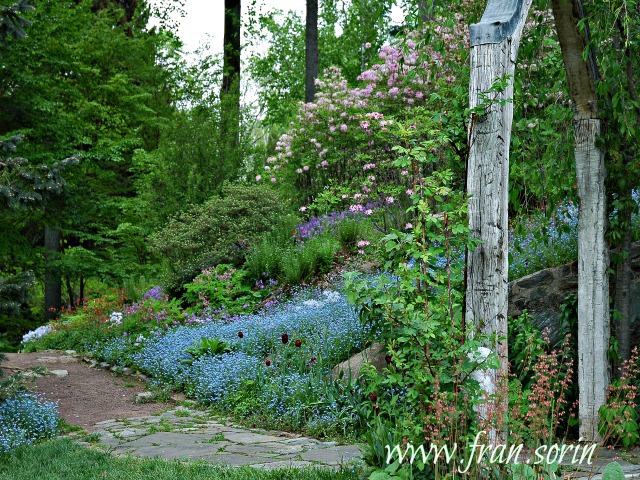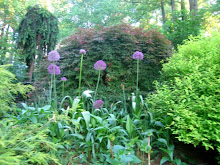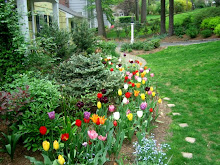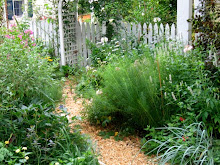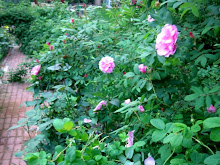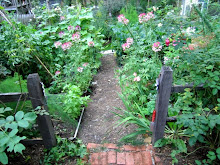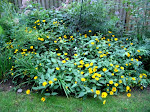Welcome to Heirloom Gardener
Sunday, July 26, 2009
Bread Seed Poppy Metamorphosis from Flower to Seed Head
Posted by
Julia Erickson
at
6:00 PM
4
comments
![]()
![]()
Labels: Poppies
Friday, June 12, 2009
Oriental Poppies (Papaver orientale) in the Egg Garden
Posted by
Julia Erickson
at
10:38 PM
7
comments
![]()
![]()
Labels: Poppies
Tuesday, November 11, 2008
Perhaps we garden bloggers can help remember our veterans and war dead by posting a picture of a poppy today?
 Many years ago, on my first trip to the U.K. during this time of year, I was struck by the fact that everyone from all walks of life wears artificial poppies in honor of those who died at war for Remembrance Day or Poppy Day. I later learned that these artificial poppies are sold as an annual fundraiser by the Royal British Legion, a charity dedicated to helping war veterans.
Many years ago, on my first trip to the U.K. during this time of year, I was struck by the fact that everyone from all walks of life wears artificial poppies in honor of those who died at war for Remembrance Day or Poppy Day. I later learned that these artificial poppies are sold as an annual fundraiser by the Royal British Legion, a charity dedicated to helping war veterans.
~
According to Wikipedia: "The poppy's significance to Remembrance Day is a result of Canadian military physician John McCrae's poem In Flanders Fields. The poppy emblem was chosen because of the poppies that bloomed across some of the worst battlefields of Flanders in World War I, their red colour an appropriate symbol for the bloodshed of trench warfare. A Frenchwoman, Anna E. Guérin, introduced the widely used artificial poppies given out today."
~
In the U.S., we celebrate Veterans' Day today for the living and reserve Memorial Day in May for the dead. Unfortunately, we do too little--we do not wear poppies or pause for two minutes of silence at eleven o'clock--on both of these holidays to truly celebrate, remember, or honor those who served and returned or those who died. Fortunately, Zoe over at Garden Hopping helped me to remember this holiday today with a picture of a poppy and this poem: Garden Hopping: Lest We Forget.
Posted by
Julia Erickson
at
11:00 AM
1 comments
![]()
![]()
Labels: Gardening Blogs, Holidays, Poppies
Tuesday, November 04, 2008
Beyond Daffodils and Tulips: Seven Minor Bulbs To Plant for Spring
Over the last week, we've had a wonderful stint of warm weather. In preparation, I cleared my schedule for a fall planting holiday. This year I tried to concentrate on the minor bulbs that often get overlooked in the mad rush to plant tulips and daffodils -- I did do a bit of that too, but we'll save that for later.
~
The minor bulbs like snowdrops, winter aconite, and bluebells are so wonderful because they can easily be tucked under deciduous shrubs and around perennials which are rarely divided like peonies and oriental poppies. Also, many of them are the first late winter flowers to appear. In zone 6, I begin getting snowdrops in early February.
~ 1. Snowdrops. I planted three varieties of snowdrops: Galanthus elwesii, Galanthus ikariae, and Galanthus nivalis flore pleno. Elwesii is the largest and first to bloom and the others follow extending the flowering from February well into April. I usually order from Van Engelen so that I can get large quantities inexpensively. Snowdrops are best planted in groups of no less than ten bulbs. Seeing that they bloom when nothing else is and that they are rodent proof, you can't have to many of them.
1. Snowdrops. I planted three varieties of snowdrops: Galanthus elwesii, Galanthus ikariae, and Galanthus nivalis flore pleno. Elwesii is the largest and first to bloom and the others follow extending the flowering from February well into April. I usually order from Van Engelen so that I can get large quantities inexpensively. Snowdrops are best planted in groups of no less than ten bulbs. Seeing that they bloom when nothing else is and that they are rodent proof, you can't have to many of them.
~ 2. Winter Aconite. Winter aconite starts blooming once the snowdrops have began. I find that they more quickly naturalize than snowdrops so I planted about a third fewer of them. I soak my bulbs for a few hours before planting because the bulbs have a tendency to dry out. I also buy from Old House Gardens whose bulbs are dipped in agricultural wax alleviating the problem of the bulbs drying out. These I scatter about in areas of the garden that have humusy soil and I know do not go dry during the summer as they like consistent moisture throughout the year.
2. Winter Aconite. Winter aconite starts blooming once the snowdrops have began. I find that they more quickly naturalize than snowdrops so I planted about a third fewer of them. I soak my bulbs for a few hours before planting because the bulbs have a tendency to dry out. I also buy from Old House Gardens whose bulbs are dipped in agricultural wax alleviating the problem of the bulbs drying out. These I scatter about in areas of the garden that have humusy soil and I know do not go dry during the summer as they like consistent moisture throughout the year.
~ 3. Tommies. On the heels of the aconite, are the tommies. Crocus tommasinianus bloom before Crocus vernus and are less frequently eaten by squirrels and chipmunks. I planted a beautiful lavender form called Roseus. These can go everywhere, but I like them along the front walk so during the cold days of early spring I don't have to venture far to take a look at them or cut them. Again, I planted in groups of ten.
3. Tommies. On the heels of the aconite, are the tommies. Crocus tommasinianus bloom before Crocus vernus and are less frequently eaten by squirrels and chipmunks. I planted a beautiful lavender form called Roseus. These can go everywhere, but I like them along the front walk so during the cold days of early spring I don't have to venture far to take a look at them or cut them. Again, I planted in groups of ten.
~
4. Glory of the Snow. Also in March, the Glory of the Snow blooms. These flowers are such an iridescent blue that they shout spring is here. I love these at the base of Magnolias which bloom around the same time.
~
5. Crocuses. By mid-April, Crocus vernus comes into bloom. The first year I planted these they appeared and flowered beautifully, only to be dug up and eaten by chipmunks immediately afterward. I think they did not dig them in the fall because I soaked them in deer repellent before planting. To avoid them from being dug up in the spring, I laid deer netting over the area for a few weeks. The chipmunks seem to forget they're there after a while and leave them alone.
~ 6. Muscari. At the end of April, muscari comes into bloom. Muscari is wonderful with late blooming daffodils and early tulips. Also, they're useful to use as a marker for where other bulbs are planted. They sprout and flower in the spring, have a typical summer dormancy, but in the fall muscari sprouts leaves again. If planted among other bulbs, it can serve as a fall marker so that the other bulbs are not accidentally displaced during the fall planting season. Although, no one bothers the muscari bulb, deer have browsed the foliage of mine.
6. Muscari. At the end of April, muscari comes into bloom. Muscari is wonderful with late blooming daffodils and early tulips. Also, they're useful to use as a marker for where other bulbs are planted. They sprout and flower in the spring, have a typical summer dormancy, but in the fall muscari sprouts leaves again. If planted among other bulbs, it can serve as a fall marker so that the other bulbs are not accidentally displaced during the fall planting season. Although, no one bothers the muscari bulb, deer have browsed the foliage of mine.
~
7. English Bluebells. English bluebells bloom in mid May along with late daffodils and tulips. English bluebells are dainty, sweet smelling flowers that are avoided by animals.
Posted by
Julia Erickson
at
12:01 AM
2
comments
![]()
![]()
Labels: Bulbs and Tubers, Poppies, Spring Garden
Saturday, July 05, 2008
Picture of a Pretty Pink Breadseed Poppy and Seedhead on Lilac Hill
Posted by
Julia Erickson
at
10:59 PM
2
comments
![]()
![]()
Labels: Poppies, Seed Heads, Summer Garden
Sunday, June 15, 2008
Garden Bloggers' Bloom Day - June 2008 (New Jersey): Roses, Eryngium, Linaria, and More
Here are some highlights from my garden for Carol's Garden Bloggers' Bloom Day June 2008: Star of the Republic is a wonderful rose introduced by Antique Rose Emporium. I usually do not like roses with apricot tones in them, but this one is beautiful. In addition, it blooms generously, is very disease resistant, and grows easily. She is planted in the triangle garden.
Star of the Republic is a wonderful rose introduced by Antique Rose Emporium. I usually do not like roses with apricot tones in them, but this one is beautiful. In addition, it blooms generously, is very disease resistant, and grows easily. She is planted in the triangle garden. An eryngium in the Front Border.
An eryngium in the Front Border. Russell's Cottage Rose is loaded with blooms that turn from deep pink to white as they age. Within each cluster of blooms you can often see a great variety of colors. This trait is quite common in the rosa multiflora hybrids. This along with their smooth canes makes multiflora hybrids my favorite climbers. She is planted in the Rose Garden.
Russell's Cottage Rose is loaded with blooms that turn from deep pink to white as they age. Within each cluster of blooms you can often see a great variety of colors. This trait is quite common in the rosa multiflora hybrids. This along with their smooth canes makes multiflora hybrids my favorite climbers. She is planted in the Rose Garden.
 Lunaria is one of my favorite edgers. The upward spikes add verticals to the garden and the soft colors compliment anything.
Lunaria is one of my favorite edgers. The upward spikes add verticals to the garden and the soft colors compliment anything.  Violetta and Penelope grow together on an oblesk in the Rose Garden.
Violetta and Penelope grow together on an oblesk in the Rose Garden. 
Sea kale is a perennial vegetable that makes a wonderful impact in the garden. It's flowers reminds one of baby's brath.
Posted by
Julia Erickson
at
10:37 PM
6
comments
![]()
![]()
Labels: Garden Bloggers' Bloom Day, Poppies, Roses, Summer Garden
Tuesday, June 03, 2008
My First Oriental Poppy of the Season
Posted by
Julia Erickson
at
10:32 PM
3
comments
![]()
![]()
Labels: Annuals/Biennials and Perennials, Cut and Forced Flowers, Poppies
Sunday, April 20, 2008
Cut Flowers, Branches, and Foliage: Bringing Early Spring Into The Home
 Cutting flowers from the garden is a beautiful way for me to bring the garden into the home. The flowers that we grow in the garden are incomparable to the ones at the florist or the supermarket. I thought this year I would keep of record of good cutting material--flowers and foliage. Almost anything can be used for arrangements, but often I overlook plants until I see a clever arrangement put together by someone else. So, please share with me the plants you like to cut and the combinations you enjoy.
Cutting flowers from the garden is a beautiful way for me to bring the garden into the home. The flowers that we grow in the garden are incomparable to the ones at the florist or the supermarket. I thought this year I would keep of record of good cutting material--flowers and foliage. Almost anything can be used for arrangements, but often I overlook plants until I see a clever arrangement put together by someone else. So, please share with me the plants you like to cut and the combinations you enjoy.
1. Cut Flowers
I mainly have spring bulbs for cutting. These include snowdrops (first picture), crocuses, daffodils (first picture), hyacinth (second picture), and early tulips. All of the bulbs will last at least a week in water, if cut when they are just about to open except crocuses. Crocuses are short lived as a cut flower, lasting only several days. Daffodils I do not mix with other flowers because the sap which oozes out of the stem poisons other flowers. I have read that if you soak daffodils in many changes of water for many hours it renders them safe to mix with other flowers. I haven't taken the time to try this, so I don't know first hand how well it works.
 The other flowers in my garden are hellebores (third picture), periwinkle, violets, and pansies (fourth picture). The violets and pansies are good for tiny vases. I will use antique shot glasses or small maple syrup bottles we've collected from Cracker Barrel.
The other flowers in my garden are hellebores (third picture), periwinkle, violets, and pansies (fourth picture). The violets and pansies are good for tiny vases. I will use antique shot glasses or small maple syrup bottles we've collected from Cracker Barrel. 2. Cut Branches
Posted by
Julia Erickson
at
8:14 PM
4
comments
![]()
![]()
Labels: Cut and Forced Flowers, Poppies, Spring Garden
Wednesday, February 06, 2008
Garden Color: Inspiration from Chanticleer in Wayne, Pennsylvania
 Chanticleer, in Wayne, Pennsylvania, is one of my greatest sources of inspiration as a gardener. It describes itself as 'America's pleasure garden' and that it is. I love Chanticleer because you can tell the staff loves plants and loves to play with them in creative combinations and venues. Everything is done to please and exite the senses.
Chanticleer, in Wayne, Pennsylvania, is one of my greatest sources of inspiration as a gardener. It describes itself as 'America's pleasure garden' and that it is. I love Chanticleer because you can tell the staff loves plants and loves to play with them in creative combinations and venues. Everything is done to please and exite the senses.
 Color at Chanticleer is as much about flowers as it is about foliage. The combination of various leaf colors, textures, and shapes makes the garden interesting without any thought to flowers.
Color at Chanticleer is as much about flowers as it is about foliage. The combination of various leaf colors, textures, and shapes makes the garden interesting without any thought to flowers. Purple leafed plants run as a theme through Chanticleer. I love how dark leaves interact with light and add a deep rich beauty which soothes the mind rather than excites.
Purple leafed plants run as a theme through Chanticleer. I love how dark leaves interact with light and add a deep rich beauty which soothes the mind rather than excites. Over the last several years of viewing Chanticleer, I have added two smokebushes (Cotinus 'Grace' and 'Royal Purple'), Rose glauca, purple phormiums, dark leafed clematis like 'Freda', amaranthus 'Hopi Red Dye' to my garden. The dark color relieves the green and really brings out any silver toned plants nearby. Also, the purple foliage looks great in floral arrangements.
Over the last several years of viewing Chanticleer, I have added two smokebushes (Cotinus 'Grace' and 'Royal Purple'), Rose glauca, purple phormiums, dark leafed clematis like 'Freda', amaranthus 'Hopi Red Dye' to my garden. The dark color relieves the green and really brings out any silver toned plants nearby. Also, the purple foliage looks great in floral arrangements. One of my favorite quotations from Christopher Lloyd as it regards planting and border design is that "you should never have to explain what you were trying to do." At Chanticleer, this rings true. All the plantings are dense, rich, and full. The feeling of abundance surrounds you. There is rarely one of anything. Instead, it's large swaths of poppies set against orange wallflowers.
One of my favorite quotations from Christopher Lloyd as it regards planting and border design is that "you should never have to explain what you were trying to do." At Chanticleer, this rings true. All the plantings are dense, rich, and full. The feeling of abundance surrounds you. There is rarely one of anything. Instead, it's large swaths of poppies set against orange wallflowers. My garden is my small piece of Eden where I can experience this. This year I want to do a combination of yellow anthemis and orange butterfly weed. I know from Chanticleer I'll want to plant more than I think of both.
My garden is my small piece of Eden where I can experience this. This year I want to do a combination of yellow anthemis and orange butterfly weed. I know from Chanticleer I'll want to plant more than I think of both.  For more information about Chanticleer, click here: http://www.chanticleergarden.org/
For more information about Chanticleer, click here: http://www.chanticleergarden.org/  This post was inspired by the "Garden Bloggers' Design Workshop - Colors in the Garden" at one of my favorite gardening blogs, Gardening Gone Wild: http://www.gardeninggonewild.com/?p=698
This post was inspired by the "Garden Bloggers' Design Workshop - Colors in the Garden" at one of my favorite gardening blogs, Gardening Gone Wild: http://www.gardeninggonewild.com/?p=698
Posted by
Julia Erickson
at
8:15 PM
7
comments
![]()
![]()
Labels: Botanical Gardens, Garden Bloggers' Design Workshop, Garden Planning, Poppies
Search Heirloom Gardener
Labels
- About Blogging
- Annuals/Biennials and Perennials
- Autumn Garden
- Books and Movies
- Botanical Gardens
- Bulbs and Tubers
- Children's Garden
- Chrysanthemum
- Clematis
- Container Gardening
- Crocus tommasiniasus roseus
- Cut and Forced Flowers
- Cutting and Rose Gardens
- Dahlias
- Deep Thoughts About Gardening
- Egg Garden
- Fences Arbors Walls and Paths
- Floral arrangements
- Front Border
- Fun Stories About Gardening
- Garden Bloggers' Bloom Day
- Garden Bloggers' Design Workshop
- Garden Planning
- Gardening Blogs
- Gardening Tools and Structures
- Gardening with Children
- Goldberry Hill
- Heirloom and Organic Food
- Hibiscus
- Holidays
- Hydrangeas
- Japanese Beautyberry
- Lilies
- Mixed Borders
- New Jersey / Local Interest
- Nurseries
- Online Gardening Resources
- Peonies
- Pest Control
- Picture This Photo Contest
- Piet Oudolf
- Poppies
- Propagation and Seeds
- Pruning and Maintenance
- Roses
- Seed Heads
- Self Seeders
- Shrubs
- Spring Garden
- Summer Garden
- Trees
- Wildlife in the Garden
- Winter Garden
- Zinia




















